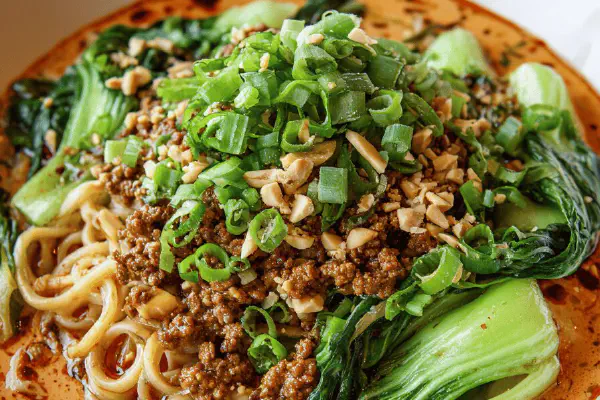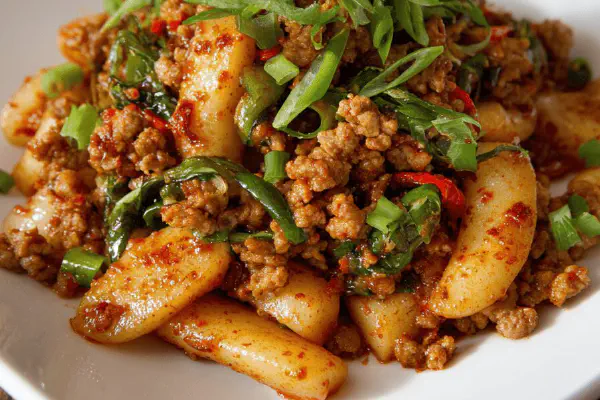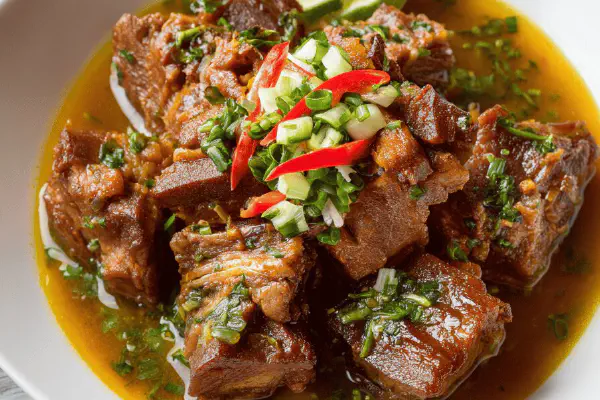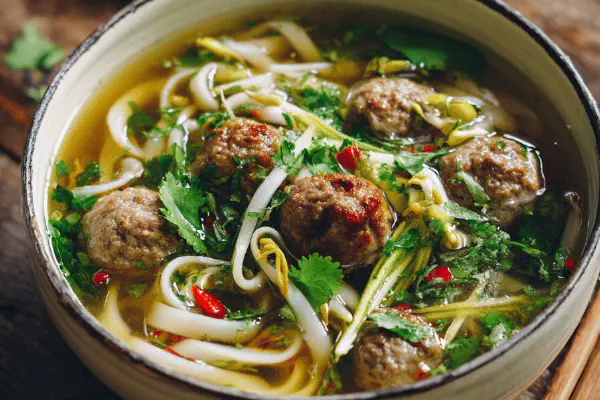Dan Dan Pork Noodles

By Emma
Certified Culinary Professional
Ingredients
Sauce
- 80 ml (slightly over 1/3 cup) toasted sesame paste or natural peanut butter (substitute tahini in pinch)
- 28 ml (2 tbsp) reduced sodium soy sauce
- 12 ml (just under 1 tbsp) dark soy sauce
- 18 ml (1 tbsp plus 1 tsp) chili crisp (store-bought or homemade, more to taste)
- 2 garlic cloves, minced
- 10 ml (2 tsp) granulated sugar
- 3 ml (just over 1/2 tsp) ground Sichuan peppercorns
Pork
- 430 g (15 oz) ground pork, preferably 80/20 mix for a bit more fat
- 15 ml (1 tbsp) vegetable oil or any neutral oil (grapeseed if you have)
- 25 ml (1 1/2 tbsp) minced fresh ginger
- 25 ml (1 1/2 tbsp) hoisin sauce (substitute with miso for funkier depth)
- 30 ml (2 tbsp) Shaoxing wine, mirin, or sake (mirin adds subtle sweetness, tried all, personal call)
Noodles and Veggies
- 4 baby bok choy, quartered
- 320 g (11 oz) ramen or egg noodles (fresh preferred, dried if desperate)
- 120 ml (1/2 cup) hot chicken stock or water (vegetable stock okay but less punch)
- 1 green onion, sliced thin
- Unsalted roasted peanuts, chopped, to garnish
- Black and white toasted sesame seeds, to garnish
About the ingredients
Method
Sauce
- Whisk sesame paste, soy sauces, chili crisp, garlic, sugar, and Sichuan pepper together till smooth. It should thicken slightly and smell fragrant with a sharp spicy bite. Set aside while you move on. Taste test - adjust chili crisp or sugar now; better before things cook off.
Pork
- Heat oil in large nonstick pan over medium-high heat. When shimmering, add pork breaking into small bits with a wooden spoon. Cook until pork starts browning and some edges crisp up, around 7–9 minutes. Look for dry bits sticking to pan, not wet pink pork. Turn heat down slightly if pork is steaming instead of browning.
- Stir in ginger and garlic, cook another 30 seconds until fragrant but no burning. Pour in hoisin and Shaoxing wine, toss well to coat pork. Cook until sauce thickens and liquid evaporates—about 4–5 minutes. You want sticky pork bits clinging to pan, shiny with sauce. Season with black pepper. If mixture looks dry too soon, splash a bit of water but not too much.
Vegetables & Noodles
- Meanwhile, bring large pot water to boil; add salt liberally to flavor noodles well. Blanch bok choy until vibrant and tender but still with snap, around 2–3 minutes. Use slotted spoon to fish out and drain well, spread on plate.
- In same boiling water, cook noodles until just al dente—fresh takes 2–3 minutes, dried might be a touch longer. Resist overcooking; noodles should spring back a bit when bitten.
- Drain noodles, drizzle with a little oil if sticking threatens. Return briefly to pot with hot broth just to warm through and loosen.
Assembly
- Divide sauce equally into four bowls. Add noodles. Spoon pork over noodles, then arrange bok choy on side for color and crunch. Pour hot broth to just cover base of bowl, coats noodles but doesn’t drown.
- Scatter sliced green onions, sprinkle peanuts and a few black and white sesame seeds over top for contrast—adds texture and extra toasty aroma. Briny bite and heat mingle. Eat immediately.
- Store leftover sauce separately; stir before serving if it settles or thickens.
Cooking tips
Chef's notes
- 💡 Pork browning is crucial. Heat must be medium-high but controlled. Listen for sizzle and popping bits. Stir often to break clumps into small fragments. Crispy edges develop aroma and texture; no steaming pork or it turns rubbery. Add ginger and garlic late to keep punching aroma. Watch garlic carefully; burnt pieces ruin sauce. For dryness mid-cook, splash small water bit, too much kills crisp finish.
- 💡 Sauce needs whisking till texture thickens—not glue but creamy and dense. Let resting time allow chili crisp oils to blend into sesame paste. Tasting at this stage helps control sugar and chili heat balance. Soy sauces layered; dark adds richness, light for umami salt. Substitute tahini with caution; loses nuttiness but keeps body. Peanut butter neutral, adds sweetness sometimes depending on brand; natural works best here.
- 💡 Veggies time matters. Bok choy blanched not boiled. Bright green with snap. 2-3 minutes max; overcooked mush kills contrast, colors dull fast. Drain fully or water dilutes broth later. Same water cooks noodles immediately after; no reheating bok choy or texture suffers. Noodles should have bite—2-3 minutes fresh, dried slightly longer. Oil drizzled post-boil stops sticking. Hot broth just warms noodles, no soaking or sogginess allowed.
- 💡 Assembling fast keeps textures alive. Spoon sauce evenly, then noodles, pork on top. Broth poured warm just to moisten base. Not drowning or washing out layers. Garnishes matter; toasted peanuts and mixed sesame seeds add crunch and aromatic lift. Green onions slice thin, scatter over last for brightness. Timing key; noodles too long and turn gluey, sauce thickens too much in serving bowl, thin with warm water when reheating leftovers.
- 💡 Broth options flexible but flavor changes. Chicken stock preferred for depth, vegetable stock ok but lighter. If none, hot water plus dash soy sauce gives umami boost fast. Shaoxing wine, mirin, or sake form flavor trio; alcohol burns off but initial aroma complex. No alcohol? Rice vinegar plus pinch sugar approximate acidity and sweetness. Adjust Sichuan peppercorns finely ground just before use — stale powder loses signature numbing effect or turns flat. Fresh cracked is best.
Common questions
How to get pork crispy bits?
Heat right. Medium-high, hear sizzle. Stir often, break chunks small. Don’t overload pan or pork steams. Dry bits stick to pan means good. Add water bit if mixture dries too soon but keep mostly dry.
Can I replace sesame paste?
Yes but careful. Natural peanut butter closest sub just different nut flavor. Tahini works but less roast depth, can feel thinner. Avoid sweetened or salted commercial pb, alters balance. Sauce changes texture slightly but still thick enough to coat.
Noodles gluey after cooking?
Timing key. Fresh noodles 2-3 minutes max, dried bit longer. Rinse not ideal. Drizzle oil post cooking to stop sticking. Do not overboil or sit too long before serving. Return briefly to hot broth only to loosen, no soaking. Assembly fast keeps them springy.
How to store leftover sauce?
Separate container cold fridge best. Sauce thickens chill so stir or thin with warm water before use. Keeps weeks covered. Avoid freezing — oils separate. Rewarm gently no boiling. Good for quick next meal flavor boost. Add fresh chili crisp on top if lost punch.



